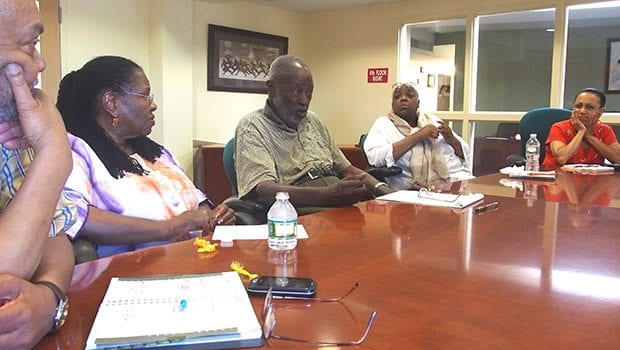Veteran activists discuss black community’s history of struggle for education equity

For many, Boston’s turbulent era of school desegregation began with black kids from Roxbury riding buses to South Boston and white kids from Southie being bused to schools in Roxbury.
But for many who were involved in the black community’s struggle for education equity, the saga began long before the first bus of black students crossed the city’s neighborhood and color lines.
“It was 1960 when Ruth Batson came to an NAACP meeting where we had our office at 451 Mass. Ave.,” recalls Long Bay Management President Ken Guscott.
At issue was a pervasive pattern of discrimination.
Guscott gathered with a half dozen other veterans of the era to discuss the history of the black community’s struggle for education resources.
“Ruth noticed that some of her white daughters were getting homework,” Guscott said. “Black children were not.”
The inequities Batson and other civil rights activists in the black community notices were real. The late Paul Parks found in a study that the average per pupil spending in predominantly black schools was just $250 a year while it was $500 in predominantly white schools.
Black students were taught in overcrowded schools. The textbooks assigned to black students were often more than 20 years old. And out of the hundreds of teachers in the system, only a handful were black. Blacks were effectively shut out of the school system’s jobs, unable to obtain even janitorial jobs in the system, which was tightly controlled by an all-white and notoriously racist school committee.
“I never had a black teacher during my years in the schools,” Guscott said.
When he graduated, and sought to pursue engineering at MIT, his teachers advised him to work in the post office. Although he was accepted at MIT, Guscott left to serve in World War II.
Former Sen. Bill Owens recalls that corporal punishment in the schools was widespread and brutal. When a white teacher at South Boston High School backhanded a young black girl, sending her falling down a flight of stairs, Owens and other black activists persuaded the student’s parents to file a lawsuit.
“We ended up in federal court,” he said, adding that the case, Murphy v. the Boston School Committee, led to the end of corporal punishment in the schools. “They were beating our kids just because they were black.”
While many in the black community were working to gain access to Boston’s educational resources, those same activists pursued a dual track persuading school districts in surrounding white suburbs to take on students from the black community.
As the veterans described, a dedicated group of activists led by Batson worked doggedly behind the scenes to lay the groundwork for efforts to secure better educational opportunities for black students.
“We met every night at the Freedom House,” said Barbara Burke. “We worked hard for years for the safety of our children.”
Guscott recalls the meeting where their organization, which later became the Metropolitan Council for Educational Opportunity, got its first commitment.
“It was on Ruthven Street on a Sunday afternoon,” he said. “The superintendent of Brookline was there and said we would send the first group of kids to his school.”
The efforts of the activists prevailed in part because of the cohesiveness of the black community in the 1960s and ‘70s, according to Cambridge College professor Lyda Peters, who is working on an oral history project on school desegregation.
“This was a small community,” said Peters, who was one of a handful of teachers in the Boston system in 1965. “People didn’t have to sit down at the same table, but they understood that they were all fighting for the same thing: Better treatment for our kids.”
The school desegregation case that became the defining event of 1970s Boston was in many ways the culmination of the years of their work. The activists pursued the issue in court because the city’s school committee blocked any attempts to redistribute resources equitably, according to Guscott.
“This was a school system as segregated as any in the South,” he said. “The difference was in the South, they had Jim Crow laws. Here we had Jim Crow practices. You can’t your hands around Jim Crow practices without going to court.”







